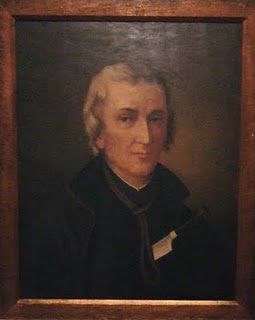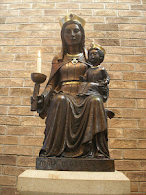Of the Forty Martyrs of England and Wales canonised on 25th October 1970 by Pope Paul VI, ten were Jesuits. The first of the ten to die was St Edmund Campion in 1581. Almost 100 years later, in 1679, the last of the ten, and the Last Welsh Martyr, St David Lewis, was executed. (SEE PREVIOUS POSTS FOR PARTS 1-4)
9) ST PHILIP EVANS, the son of William Evans and Winifred Morgan, was born at Monmouth in 1645. He was educated at St Omer and entered the Jesuit Novitiate at Watten on 7th September 1665. Having completed his training, he was ordained at Liege in 1675 and sent upon the English Mission. Back in Wales, he worked diligently for four years, saying Mass, administering the Sacraments and preaching in Welsh and English. It is known that he ministered to large congregations at the home of Thomas Gunter in Abergavenny, at the home of Charles Prodger at Wernddu, and at Sker House, the home of Christopher Turberville. During the wave of persecution generated by the Popish Plot, friends advised Fr Evans to go into hiding. However, he refused and bravely continued his work. On 4th December 1678, the priest was arrested at Sker House, betrayed by the owner’s younger brother, Edward Turberville, a lapsed Catholic. He was imprisoned in Cardiff Castle Gaol and kept in solitary confinement in the dungeon. After several weeks, he and another Welsh priest, Fr John Lloyd, who had been arrested in November, were permitted to share a cell. The following May, Fr Philip Evans was tried at Cardiff Assizes, found guilty of the treason of priesthood, and sentenced to death. The execution was delayed for some time and Fr Evans was even allowed out of prison for recreation! Eventually, on 21st July, orders arrived that his execution was to take place the following day. At that time, he was playing tennis on the court near St John’s Church. When the gaoler went to the tennis court to tell the priest the news and to return him to prison, Fr Evans remarked, “What haste is there? Let me first play out my game.” This he did! Sister Barbara Catherine, the sister of Fr Philip Evans, was a Blue Nun in Paris. The day before his execution Philip wrote to her. He told her of his situation and urged her to be joyful instead of mourning for him. Promising to pray for her, he asked that she pray for him. Philip was a skilled harpist and when the officials came next morning to lead him to his execution, they found the priest joyfully playing the harp. Philip’s legs had been bound with heavy chains. They were so tight that the struggle to remove them lasted more than an hour and caused the poor priest indescribable agony. Taken to the place of execution, Fr Evans addressed the crowd in both Welsh and English. To Fr Lloyd, who had to watch his friend’s martyrdom, he said, “Adieu, Mr Lloyd! Though only for a little time, for we shall soon meet again”. On 22nd July 1679, 34 year old Fr Philip Evans S J, was hanged, drawn and quartered at Gallows Field (the northern end of Richmond Road) Cardiff.
10) ST DAVID LEWIS, (alias Charles Baker) was born in Abergavenny in 1616, the son of Margaret Pritchard and Morgan Lewis. His father was headmaster of Abergavenny Grammar School. It is not certain if Morgan Lewis was a Protestant or a Church Papist, but, to all appearances, he was a Protestant. Margaret was a staunch Catholic and eight of their nine children were brought up as Catholics. However, Morgan raised David in the Protestant religion. As a young man David spent some time in Paris and while there he converted to Catholicism. He went to study at the English College in Rome where, in 1642, he was ordained as a Catholic priest. Following the example of his uncle, Fr John Pritchard, Fr Lewis decided to join the Society of Jesus and entered the Jesuit Novitiate at Sant’ Andrea. Upon completion of his novitiate, Father David Lewis returned to his native Wales but after about a year, he was recalled to Rome. A year later he was sent back to Wales where he spent his remaining 31 years labouring for the people of Monmouthshire and area. He was greatly loved and, for his kindness to all, he was known as ‘Tad y Tlodion’, ‘Father of the Poor’. Father Lewis became a victim of the evil Titus Oates and the fictitious Popish Plot. On 17th November 1678, as he prepared to celebrate Mass, he was arrested at Llantarnam, Cwmbran. The Jesuit was brought for trial at the Lenten Assizes in Monmouth on 16th March 1679. He was brought to the bar on a charge of High Treason, that is, for having become a Catholic priest and remaining in the country. He pleaded not guilty to the charge of being an accessory to the Popish Plot but several witnesses claimed they had seen him say Mass. For this he was found guilty and the judge, Sir Robert Atkins, sentenced him to death. The condemned priest was brought to London and lodged in Newgate Prison. Oates, William Bedloe, Dugdale and Price questioned Fr Lewis about the “plot” but were unable to prove anything against him. Lord Shaftsbury tried to bribe him, telling him that if he gave evidence about the “plot” or renounced his Catholic faith, his life would be spared and he would be handsomely rewarded. The heroic priest could not be swayed. David Lewis said in his dying discourse, “discover the plot I could not, as I knew of none; and conform I would not, for it was against my conscience”. He was brought back to Usk Gaol to await his execution, which came on 27th August 1679. He was taken from his cell in Usk Gaol and carried on a hurdle along the river path to a place known as the Coniger. After addressing the gathering and praying, the condemned man was hanged. A Protestant man held the priest’s hand, ensuring that he was dead before the rest of the barbaric sentence could be carried out. Although the greatly loved priest was drawn and decapitated, he was not quartered. His body was taken in procession to the churchyard of the Priory Church and there it was reverently buried near the main door of the church. St David Lewis was the last Welsh Martyr to suffer for the Catholic faith. He was also one of the ten Jesuit martyrs to be canonised among the Forty Martyrs of England and Wales.
Friday, 6 November 2009
TEN WERE JESUITS (CONCLUDED)
Subscribe to:
Post Comments (Atom)









.JPG)

.JPG)






Aloha, thank you for posting on these martyrs. I will use your blog for future references. God bless.
ReplyDeleteWelcome Esther G,
ReplyDeleteIt is nice to hear from you. I am happy you find the blog interesting and very pleased if you find it useful. Our main objective is to spread the word on St David Lewis, the last Welsh Martyr, but so many wonderful people, men and women, gave their lives for Christ, that we have to tell their story too. God bless you, Esther.